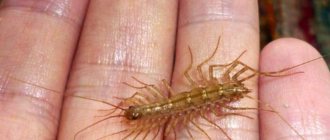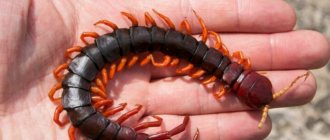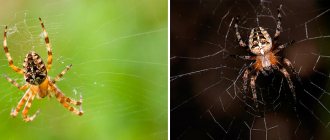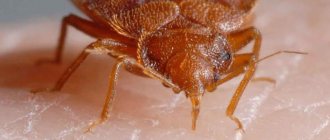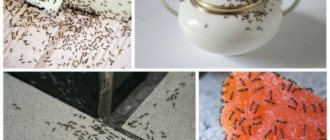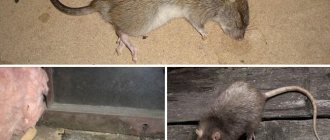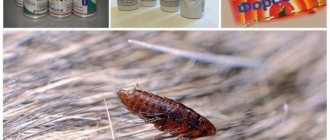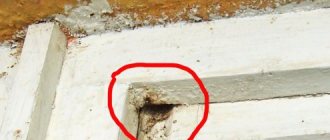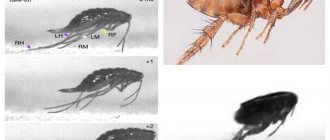The appearance of harmful creatures in the house is not only unpleasant, but also dangerous. Even if they do not drink the blood of household members, they can become a source of infections, and the risk of contracting a serious disease increases accordingly.
Everyone knows about the threat posed by cockroaches, but two-tailed cockroaches, or as they are also called, forktails, are often considered as unpleasant, but harmless creatures. At the same time, they are carriers of pathogenic microflora and therefore their presence in the house is unacceptable.
Appearance and lifestyle of the two-tailed woman
Although the double-tailed bird is similar to an earwig with its forked tail, it belongs to a completely different class of animals - cryptomaxillary and is not an insect. You can recognize it by its white color; it has no pigmentation. She also lacks eyes and wings, but her antennae are quite long and directed forward.
The size of the two-tailed fish, which can be noticed by residents or caught by pets, rarely exceeds 1 cm. Larger species are found only in tropical countries. The chest and abdomen of the animal consists of clearly defined segments. Six long legs help her quickly escape in any danger. Moreover, it can move both forward with its head and in the opposite direction.
Appearance
From the very tip of the abdomen extend two peculiar processes called cerci, which resemble a tail. Thanks to them, the two-tailed one got its name. Depending on the type of forktail, they have different shapes. They can be long and thread-like, or short, mite-like. It is interesting that only these arthropods, having lost their cerci, can regrow them.
Pests live mostly in the ground and are very secretive. It is almost impossible to see them during the day. Only late at night do they come to the surface. For life and reproduction, they require a moist environment, so in dry years they tend to settle in vegetable gardens and orchards where there is constant watering. They are attracted to people's homes by high humidity, comfortable air temperatures and secluded corners where they can hide.
Interesting Quick Facts About Earwigs
- The second name of the earwig in Russian is two-tailed. Although the two-tailed insect is a completely different type of insect, which has neither direct nor indirect relation to earwigs.
- Earwigs are quite large creatures for the animal world. Their length can reach from 1 to 5 cm in length depending on age and species.
- Their bodies are dark brown, red-brown or black in color, adorned with a fine texture.
- The body is long, narrow, flattened with 3 pairs of legs. Most species have short, leathery forewings and thin hindwings, but the insects rarely fly.
- Earwigs are terrestrial animals that live primarily on the surface of the earth, although during the winter they can burrow a couple of tens of centimeters deep.
- The insect has a pair of antennae on its head, consisting of ten or more segments. Using sensors in their antennae, earwigs find food and respond to light.
- Due to the presence of “pincers” on the rear end of the body, earwigs began to be called two-tailed earwigs. They need this tool to simplify the capture of prey, and also serve as a weapon against predators.
- Females and males are easily distinguishable even by those who do not have special knowledge of entomology. Males tend to be darker, rougher and larger. The branches of their pliers are rounded.
- Earwigs get their name from the false belief that they often burrow into human ears and lay eggs inside the human brain. Although they can make their way into the outer ear canal, they prefer to stay away from there due to the lack of food and moisture in the ear canal.
- Earwigs are harmless to humans. They do not transmit diseases, and their bite, or rather pinching by ticks, does not contain poison.
- Insects are predominantly nocturnal. During the day, they sit in dark and damp places - inside hollow rotting trees, under stones, leaves, bark. They are very fond of cracks in the foundations of residential buildings, from where they crawl inward.
- Earwigs feed mainly on leaves, flowers, fruits, and moldy fungi. However, they are omnivores and can eat small insects, such as aphids, which provide invaluable support to gardeners. In addition, the insect is not very selective in the quality of its food; it can consume both fresh and dead rotting plant materials.
- Earwigs live in large groups. They secrete pheromones that help them find each other, so if one insect is found on the floor in the house, you need to look for a second one somewhere nearby.
- Earwigs also produce and release foul-smelling substances to ward off predators. This liquid contains no poisons.
- Natural enemies of earwigs include birds, insectivorous mammals, lizards, frogs, centipedes and spiders.
- The insect mating season occurs during the fall. Females store the male seed in their bodies until spring, when it is used to fertilize the eggs.
- The female lays 3 to 50 eggs, which hatch after 7 days. The larva (nymph) emerges from the egg and undergoes 4 to 6 molts before it finally reaches the size of an adult insect. The whole process takes 20-30 days, which is quite short for the insect world.
- Unlike other types of insects, females are able to take care of their offspring until the second or third molt. These are almost the only insects that know how to do this and do it.
- Earwigs can survive up to one year in the wild, which is also quite long compared to other insects.
How to find two-way in a private house or apartment?
Most often, these creatures inhabit private houses, climbing into them from their garden plots. A two-tailed man is a rarer guest in his apartment. Thanks to their small size, secretive lifestyle, and reluctance to stray far from their shelters, they manage to exist next to humans for many years before they are discovered. This usually happens by accident or during repairs. Most often, two-tailed insects live in places where it is dark and the humidity is quite high: basements, bathrooms, toilets, in the kitchen under the sink. Flower pots can also be used.
It’s difficult to figure out where the double-tails come from in an apartment. The small size of the creature allows it to use any gap near pipelines or in the floor to penetrate a person’s home. The forktail crawls well on horizontal surfaces and often sneaks through windows. It can easily be brought in along with vegetables dug from the beds.
If at least one individual of the two-tailed fish has appeared at home, then it is worth inspecting the places where they could potentially be hiding. Most likely, an unpleasant surprise in the form of many creatures hiding from human eyes will not be long in coming.
What harm do double-tails do?
The two-tailed insect has a very unpleasant appearance and it is this circumstance that makes a person panic at the sight of an insect, especially if he does not have truthful information. The most common superstition is that two-tailed insects crawl into a person’s ear at night, gnaw through the eardrum, reach the brain and begin to multiply there. In fact, this statement does not correspond to reality. Of course, a two-tailed snake can crawl into a person’s ear and even bite, because the person tosses and turns at night, but the likelihood of this is very low. In the same way, any other insect can get into a person’s ear.
Not knowing anything about this insect, people are afraid that it can sting painfully with powerful “pincers”. But you need to know that insects are not poisonous. They will never attack a person unless they feel a threat coming from him. But even if the two-tailed fish has bitten, there is no need to panic. If a person is not allergic to insect bites, then a double-tailed insect bite will not cause much harm. A small wound appears at the site where the skin is grabbed by the “forceps”. The skin in this area turns red, swells, and itches. But soon all the unpleasant sensations pass. To avoid more serious consequences, the bite site must be disinfected immediately.
Insects have a terrifying appearance that usually causes disgust. They are relatively large and their tail extensions can be intimidating, especially if encountered at night.
Two-tailed insects feed on plant matter and therefore, if the insect population is not controlled or completely destroyed, they can cause serious damage. So, they eat fruits that have fallen to the ground. Vegetable crops also suffer from them, since insects can eat the leaves and fruits of beets, cucumbers, tomatoes, and potatoes. In the spring, they can spoil pepper and tomato seedlings, and can also nibble on indoor flowers.
Pests cause damage to beekeeping. They climb into the hives and eat beebread and honey there.
Oddly enough, in some cases, two-tailed plants can be beneficial, especially if they live in garden plots. The thing is that they love to eat small insects. By eating aphids and other plant pests, they protect cultivated seedlings. The only thing is that you need to make sure that there are not too many of them, otherwise instead of benefit there will only be harm.
How to get rid of the two-east invasion in the house?
Having discovered forktails at home, you need to immediately begin measures to get rid of them in a short time. For this purpose, both purchased and folk remedies are used.
Chemicals
Insecticides will help deal with double-tailed insects quite quickly. When deciding what to poison them with, you need to choose pesticides against crawling insects. Do not be alarmed if, when spraying solutions, these creatures begin to show unprecedented activity. In a short time they will die. Effective means are:
- Aerosol "Raptor". It helps to quickly remove double-wort, it is easy to use, easy to store, convenient to treat hard-to-reach areas, just where these creatures like to hide.
- Anti-bug solution is suitable for wooden surfaces. Can be applied with a spray or brush. Treat floors, thresholds, and wood furniture. It kills not only two-horned beetles, but also wood-boring beetles.
- Spray "Combat" will destroy all crawling insects in the apartment.
Combat
- Tarax powder. It is diluted in water and applied with a sponge to places where pests live. You can use a spray bottle. Negatively affects two-east, cockroaches, ants, woodlice.
- Sulfur bombs are a highly effective remedy for bivostok, but they can only be used in a private home.
- Cockroach chalk also works on the order of cryptomaxillaries.
To treat indoor plants, you can use the preparations “Inta-Vir”, “Bankol”, “Aktellik”.
Folk remedies
Knowing what forktails fear and love, you can use this to fight them.
Among the folk remedies that can be used to get rid of double-tails in the house, we can mention the following:
- Onion-garlic infusion. One hundred grams of garlic and the same amount of onion are ground and poured with boiling water. A day later, the resulting mixture is applied to the pest habitats. Unable to bear the strong smell, they leave the house.
- Herbal decoction. For preparation, you can take yarrow, tansy, wormwood, lavender. For 1 liter of water add 1 tbsp. l. dry plant or a bunch of freshly cut ones. Boil for 10–15 minutes. After cooling, filter and add washing powder or liquid dishwashing detergent. Use a brush to treat surfaces where two-tailed beetles are found.
- Traps from a box with damp rags help to collect a certain number of individuals, but it will not be possible to completely get rid of pests this way.
- The poison from dvostok is prepared from boiled egg yolk with boric acid. Small balls of bait are placed in the rooms where the forktail is found.
How to fight on a personal plot?
To get rid of two-east suburban areas, agrotechnical techniques, pesticides and folk remedies are used.
Autumn digging of the earth destroys nests with clutches and winter burrows of pests. This leads to the death of arthropods.
With small amounts of bivost, biological products help well. When pests become infested, you have to resort to insecticides, but this treatment is best done in the spring or autumn after harvest.
Wormwood decoction
Herbal decoctions are also used in areas. The downside is that it is difficult to process a large area in this way.
Double-tails: why they are dangerous and how to get rid of them
One female double-east lays from 20 to 60 eggs at a time, so the number of “aliens” is growing rapidly. They are able to move long distances, looking for dark areas with high humidity.
Forktails have favorite places:
- damp basement;
- bathrooms and showers;
- baseboards;
- cracks in walls, floors;
- pots with indoor plants.
In gardens, areas with high humidity are found under autumn leaves, near roots, between and under stones, in places where sewer pipes leak, and near wells. This is where they spend the winter. Insects are silent and crawl out only at night, so a person may not immediately notice their presence in the house.
Attention! If woodlice and centipedes are present in the bathroom or basement, then there is a high probability that two-tailed insects also live there.
They can get into the house along with vegetables and fruits brought from summer cottages or purchased at the market. Many years of experience show that insects are afraid of unfavorable conditions for them, so they are easily destroyed, both by professional chemicals and folk remedies.
Help from a specialized service
Sometimes it’s not possible to get rid of double-east for a long time in a private house. They try to get into the house again and again. This happens if the building is located in a low area and the groundwater is shallow. You have to resort to the services of specialized organizations. When exterminating two-worts, professional chemicals are used that reliably protect the home from pests for a long time.
If forktails have settled in the basement of an apartment building, then at the request of the management company, exterminators must treat the premises, which will quickly get rid of unpleasant roommates.
Preventive measures
Knowing the two-easter’s love for both high humidity and secrecy, you can not only get rid of them at home, but also prevent their appearance. Making your home unattractive to pests is not difficult. To do this, you need to sort out all the trash, eliminate leaks and causes of condensation, and constantly ventilate the room. Dry climates are unsuitable for forktails. Seal the cracks in the floor and around the baseboards, making it impossible for them to hide.
Based on this it follows:
- Seal holes near pipes of water supply and sewerage systems.
- Seal cracks in the floor, baseboards, foundation and walls of the building.
- Dry the basement.
- Do not leave windows open without a mosquito net. Tighten the ventilation holes with it.

